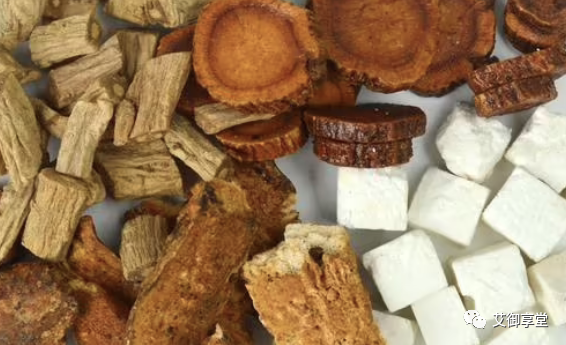Inheriting the legacy of Qi Huang, a public account with substance and warmth.
Ai Yu Xiang Tang
“When wind prevails, it causes movement; when heat prevails, it causes swelling; when dryness prevails, it causes dryness; when cold prevails, it causes floating; when dampness prevails, it causes diarrhea.” This is a description of the clinical manifestations of diseases caused by the six excesses (liuxin) in the “Su Wen: Yin Yang Ying Xiang Da Lun”. Generally speaking, the changes in the four seasons and five elements in nature produce different climates of cold, heat, dryness, dampness, and wind. Excessive cold, heat, dryness, dampness, and wind can harm the body, leading to the six excess pathogenic factors. Excessive wind can lead to various diseases characterized by movement, such as tremors in the limbs or dizziness; excessive dryness can cause the body fluids to dry up, leading to dryness of the orifices and skin, with scanty urination and dry stools; excessive heat can cause stagnation of the nutritive qi, resulting in abscesses and swelling; excessive cold can damage yang qi, leading to water retention and edema; excessive dampness can obstruct the spleen, impairing its function, causing irregular ascension and descent, and resulting in diarrhea, hence damp diarrhea is also known as wet diarrhea.

Firstly, “When wind prevails, it causes movement; when heat prevails, it causes swelling; when dryness prevails, it causes dryness; when cold prevails, it causes floating; when dampness prevails, it causes diarrhea” proposes that different causes can lead to different disease manifestations. Wind, heat, dryness, cold, and dampness are elements of climatic change in nature, each with its own symptoms when excessive, and their pathogenic effects manifest as corresponding disease signs. The terms movement, swelling, dryness, floating, and diarrhea represent these corresponding disease signs.Secondly, based on the disease manifestations, we explore the causes and pathology, which introduces the concept of differential diagnosis of causes. This is of great significance for clinical analysis of disease mechanisms and establishing treatment methods. The key point of differential diagnosis of causes emphasizes that the causes are not only the external climatic factors of cold, heat, dryness, dampness, and wind (the six excesses) but also refer to similar internal pathological causes that arise within the body, hence termed “internal generation of six qi”. This later became known as the pathophysiological theory of “six qi as disease”. For example, symptoms such as tremors and shaking are viewed as manifestations of internal wind, while the signs of dried body fluids are attributed to internal dryness, which is an application of the original text.Of course, the judgment of disease manifestations in clinical practice also follows certain rules. Taking “when wind prevails, it causes movement” as an example, the judgment of the “movement” sign mainly follows two points: first, “movement without movement”, meaning that areas of the body that normally do not exhibit movement show abnormal movement signs, such as muscle twitching or facial spasms; second, “movement that is excessive”, meaning that areas of the body that normally exhibit movement show abnormal excessive movement signs, such as head shaking, limb spasms, tremors, or asthma. These abnormal movement signs can be considered from the perspective of wind. Similarly, for dryness, the judgment is based on signs such as dryness of the orifices and skin, cracked skin, dry mouth and tongue, scanty urination, and dry stools, but without obvious heat signs, such as yellow urine, yellow phlegm, red tongue with yellow coating, etc. Otherwise, one should consider heat injuring body fluids rather than dryness.Finally, based on the causes, we should analyze and treat the disease, as the saying goes, “treat the root of the disease”. It is important to note that once the cause is clarified as external or internal, the treatment methods for the six excesses differ from those for “internally generated six qi”. For example, for itching of the throat and paroxysmal cough caused by external wind, the main treatment should focus on dispersing external wind; while for asthma and cough caused by internal wind, the focus should be on calming the liver and extinguishing wind. On this basis, one can then descend lung qi and stop cough to relieve asthma. Furthermore, dryness is associated with the autumn season, corresponding to the metal element, which governs the functions of collection and descent. The signs of dryness are caused by the dysfunction of qi mechanism in collection and descent, leading to improper distribution of body fluids. Therefore, warming and bitter herbs should be used to disperse it. The “Su Wen: Zhi Zhen Yao Da Lun” states: “When dryness is excessive internally, treat with bitter warming herbs, supplemented with sweet and pungent herbs to drain it.” The “Su Wen: Zang Qi Fa Shi Lun” states: “Quickly consume pungent herbs to moisten it, open the pores, promote body fluids, and facilitate qi” which serves as an excellent treatment guideline. Clinically, the use of Xing Su San (Xing Ren, Su Ye, Ban Xia, Fu Ling, Qian Hu, Jie Geng, Zhi Ke, Sheng Jiang, Ju Pi, etc.) and Sang Xing Tang (Sang Ye, Xing Ren, Dou Chi, Zhe Bei, Sha Shen, Zhi Zi Pi, Li Pi) to treat dryness is a direct application of this principle. As for the treatment of internal dryness, it should be based on symptoms and differentiation of organs for treatment.
Diseases caused by the six excesses, particularly dampness, are more complex and variable among wind, cold, heat, dampness, and dryness. Later generations have further developed the theory of “when dampness prevails, it causes diarrhea”. For instance, Shen Jin Ao in “Za Bing Yuan Liu Xi Zhuo: Xie Xie Yuan Liu” states: “When dampness prevails, it causes diarrhea, is it solely due to dampness? It is not known that wind, cold, heat, and deficiency can all cause disease. If the spleen is strong and there is no dampness, none of the four can affect it, how can diarrhea occur? Thus, although diarrhea may have different causes of wind, cold, heat, and deficiency, it has never been without dampness as its source.” This emphasizes that the treatment of diarrhea should first focus on regulating the spleen and eliminating dampness. Moreover, since there are various methods to eliminate dampness, the clinical treatment methods and formulas for dampness vary. For example, strengthening the spleen to transport dampness, using bitter warming herbs to dry dampness, using bland herbs to drain dampness, using aromatic herbs to transform dampness, assisting yang to warm and transform cold dampness, and using bitter cold herbs to clear and drain damp-heat.
Strengthening the spleen and transporting dampness to treat diarrhea: Li Zhongzi in “Yi Zong Bi Du: Xie Xie” states: “When the spleen is strong, it can naturally overcome dampness; without dampness, there is no diarrhea.” Since the spleen can transform and transport water and dampness, many tonifying and strengthening spleen formulas have the function of treating diarrhea, such as Shen Ling Bai Zhu San (Bai Bian Dou, Ren Shen, Bai Zhu, Fu Ling, Gan Cao, Shan Yao, Lian Zi Rou, Jie Geng, Yi Yi Ren, Sha Ren), Si Jun Zi Tang (Ren Shen, Gan Cao, Fu Ling, Bai Zhu), and Yi Gong San (Si Jun Zi Tang plus Chen Pi) from Qian Yi’s “Xiao Er Yao Zheng Zhi Jue”, and Bu Zhong Yi Qi Tang (Huang Qi, Gan Cao, Ren Shen, Dang Gui, Ju Pi, Sheng Ma, Bai Zhu) from Li Dongyuan’s “Pi Wei Lun”, all of which have the effect of treating spleen qi deficiency diarrhea.Bitter warming to dry dampness to treat diarrhea: The “Su Wen: Zhi Zhen Yao Da Lun” states: “When dampness is excessive internally, treat with bitter heat, supplemented with sour and bland to dry it.” The “Su Wen: Zang Qi Fa Shi Lun” states: “The spleen is bitter and damp, quickly consume bitter herbs to dry it.” The Ping Wei San in the “He Ji Ju Fang” is used to treat loss of appetite, vomiting, and diarrhea due to disharmony of the spleen and stomach, with Cang Zhu and Hou Po being bitter warming agents; Huo Xiang Zheng Qi San is used for diarrhea due to external wind-cold and internal damp stagnation, using bitter warming Chen Pi, Ban Xia, and Hou Po; the Liu He Tang in “Yi Fang Kao” treats cholera and vomiting due to damp injury to the spleen and stomach, using Sha Ren, Ban Xia, and Hou Po.Bitter cold to clear and drain damp-heat: Bitter cold herbs are used to treat damp-heat diarrhea, such as the Ge Gen Qin Lian Tang in the “Shang Han Lun” for heat diarrhea, using Huang Qin and Huang Lian; the Lian Pi Yin in the “Huo Luan Lun” treats cholera with damp-heat accumulation, using Huang Lian as the main herb, etc.Warming yang to transform dampness to treat diarrhea: Dampness is a yin evil, and when yang is obtained, it can be transformed. Therefore, using warming and yang-assisting herbs to warm and transform cold dampness can help stop diarrhea. For example, the Si Shen Wan in the “Nei Ke Zhai Yao” treats early morning diarrhea, with ingredients including Bu Guo Zhi, Rou Dou Kou, Wu Zhu Yu, Wu Wei Zi, Sheng Jiang, and Hong Zao, where Bu Guo Zhi and Wu Zhu Yu are both great warming agents that can warm and tonify yang qi. The Si Ni Tang (Fu Zi, Gan Jiang, Gan Cao), Bai Tong Tang (Cong Bai, Gan Jiang, Fu Zi), Wu Zhu Yu Tang (Wu Zhu Yu, Ren Shen, Sheng Jiang, Da Zao), and Zhen Wu Tang (Fu Zi, Sheng Jiang, Fu Ling, Shao Yao, Bai Shao) can all treat diarrhea with clear stools, which can be seen as specific applications of warming yang to transform dampness for treating diarrhea.Bland draining to benefit dampness to treat diarrhea: Zhang Jie Bin in “Jing Yue Quan Shu: Xie Xie” states, “In all cases of diarrhea, it is often due to the inability to separate water and grain, thus draining water is the best strategy… When water and grain are separated, diarrhea will stop, hence it is said that treating diarrhea without draining small water is not the right treatment.” Later generations have the saying, “drain small water and solidify large water.” Typical formulas for treating diarrhea with this method include Wu Ling San from Zhang Zhongjing’s “Shang Han Lun”, which is believed to treat not only bladder water retention but also cholera and alternating vomiting and diarrhea. In the Ming Dynasty, Zhu Danxi used Wu Ling San and Ping Wei San to create Wei Ling Tang to treat abdominal pain and diarrhea due to heatstroke and food injury. The Liu Yi San, composed of Hua Shi and Gan Cao, is used to treat vomiting and diarrhea due to summer dampness, and its principle is also based on this.In summary, although different schools have different discussions and formulas, they all originate from the theory of “when dampness prevails, it causes diarrhea” in the “Huang Di Nei Jing”. From this, we should recognize the significant impact of “when wind prevails, it causes movement; when heat prevails, it causes swelling; when dryness prevails, it causes dryness; when cold prevails, it causes floating; when dampness prevails, it causes diarrhea” on TCM theory, laying the foundation for the establishment of TCM pathogenesis and differential diagnosis and treatment thinking.This is for clinical reference only; non-professional doctors should not attempt acupuncture or medication.
Copyright Statement: Editor/Yi Dan Proofreader/Feng Tu/Source from publicly available online materials Copyright belongs to the original author.
If you find this useful, please give a thumbs up or read more!

